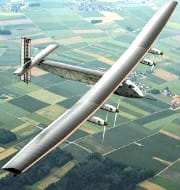Solar Impulse 2 completes historic round-the-world trip
The Solar Impulse 2 has become the first aircraft to circle the globe using solar energy after landing in Abu Dhabi on the last leg of its journey.
In its journey, the long-range solar-powered aircraft has travelled 26744 miles across four continents, three seas and two oceans since setting off from Abu Dhabi in March 2015.
Key features of Solar Impulse 2
- Solar Impulse 2 is a Swiss long-range solar-powered aircraft project. It is first aircraft to fly day and night without consuming conventional fuel in oder to promote renewable energy.
- Its construction was started in 2011. The first test flight of the aircraft was conducted in the United States in 2013.
- Structure: Single-seater aircraft made of carbon fibre. It has a 72 metre wingspan and weighs 2,300 kilo grams. It is solely propelled by the solar energy and emits zero Carbon dioxide (CO2).
- Solar cells: 17,248 solar cells inbuilt into its wings. These cells supply renewable energy to propel the electric motors of aircraft.
- These solar cells also recharge 4 lithium polymer batteries mounted on aircraft which allows it fly at night.
Journey of Solar Impulse 2
- In its 17-leg voyage, the aircraft has racked up 558 hours of flight time. The aircraft was piloted in turns by Markus Scherdel, Andre Borschberg and Bertrand Piccard.
- Started its journey from Abu Dhabi (UAE). Its first halt was in Muscat (Oman). Later halted in Ahmedabad and Varanasi in India.
- Later it had halted in Mandalay (Myanmar), Chongqing & Nanjing (China). It had made an unscheduled stop in Japan to await favourable weather over the Pacific.
- From Japan it crossed the Pacific Ocean via Hawaii (US) and flew across the United States, taking 3 stops at Phoenix, the Midwest and New York City.
- Then it crossed Atlantic Ocean and took halt in Seville, Spain in Europe. Later in its final leg it landed in Cairo, Egypt and completed its journey in Abu Dhabi.
Month: Current Affairs - July, 2016


